Anonymous Poster
New member
- Joined
- Sep 27, 2005
- Messages
- 0
<font color="blue">There is no compact utility tractor that can handle anything more than 20 degrees at the very most.</font>
Hi,
Boy, that is a pretty strong statement!
While I agree that crossing a 20 degree slope [or greater] is something I want to avoid, I doubt that what you state is true.
Can you site a reference? I don't mean to be antagonistic [sorry, no spelling checker here... /forums/images/graemlins/smile.gif] but from what I have seen looking at the geometry of MY tractor, I truly believe that if I take care and go slowly, I can easily traverse a 20 degree slope safely.
But in the end, your statement sends the right message. The need to be VERY cautious when crossing slopes cannot be argued.
R4 tires on slopes...wet slopes...I was amazed at how I broke into a slide on a wet slope. I say the original poster should go with the R1s if he is going to be on those slopes when it is wet. My opinion anyway...
Hi,
Boy, that is a pretty strong statement!
While I agree that crossing a 20 degree slope [or greater] is something I want to avoid, I doubt that what you state is true.
Can you site a reference? I don't mean to be antagonistic [sorry, no spelling checker here... /forums/images/graemlins/smile.gif] but from what I have seen looking at the geometry of MY tractor, I truly believe that if I take care and go slowly, I can easily traverse a 20 degree slope safely.
But in the end, your statement sends the right message. The need to be VERY cautious when crossing slopes cannot be argued.
R4 tires on slopes...wet slopes...I was amazed at how I broke into a slide on a wet slope. I say the original poster should go with the R1s if he is going to be on those slopes when it is wet. My opinion anyway...
